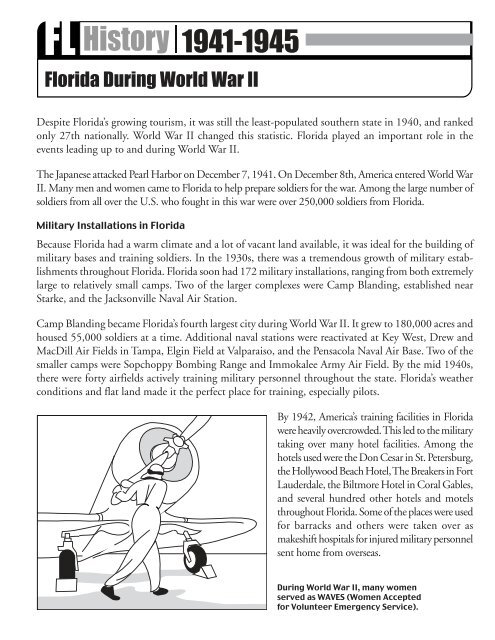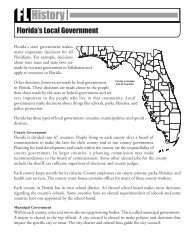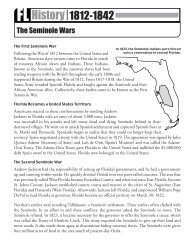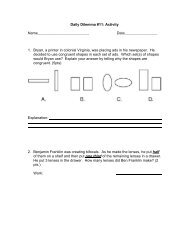Florida During World War II
Florida During World War II
Florida During World War II
- No tags were found...
Create successful ePaper yourself
Turn your PDF publications into a flip-book with our unique Google optimized e-Paper software.
1941-1945Events in <strong>Florida</strong><strong>World</strong> <strong>War</strong> <strong>II</strong> took place closer to the United States than many people ever realized. German U-Boatstook advantage of mistakes made by the United States Intelligence Department. German U-Boatssank over twenty-four ships off of <strong>Florida</strong>’s Atlantic and Gulf Coasts. Many ships could be seen burningfrom areas along the coast by Floridians and tourists. In late February 1942, German submarinesattacked four merchant ships right off the east coast of <strong>Florida</strong> near Cape Canaveral. German spieswere able to come on shore at Ponte Vedra (near Jacksonville). They were captured before they couldblow up <strong>Florida</strong>’s railroad lines and stop the shipment of war supplies.The Civil Air Patrol was organized in March 1942, to protect the coasts of <strong>Florida</strong>. The “MosquitoFleet” also helped to protect the coastlines of <strong>Florida</strong>. These convoys helped to eliminate the threat ofsubmarines. Thousands of volunteers, called spotters, were trained to keep track of air activity up anddown both shores.Economic Stimulus for <strong>Florida</strong><strong>World</strong> <strong>War</strong> <strong>II</strong> provided the greatest economic growth in American history. The war effort sent largeamounts of money into <strong>Florida</strong>, leading to rebuilding and even growth after the Great Depression.<strong>War</strong> contracts helped to rebuild <strong>Florida</strong>’s manufacturing, agricultural, and tourism businesses. Defensecontracts revitalized Tampa after the city suffered severe economic cutbacks during the Great Depression.The local cigar industry had been wiped out by the depression and many workers were unemployed,but the construction of MacDill Air Field and two large shipbuilding companies employed thoseworkers with premium wages. <strong>War</strong> contracts also help other cities recover, including Pensacola,Jacksonville, Miami, and Orlando. <strong>Florida</strong>’s nickname almost changed from the Sunshine State to theSteel State.With the rebuilding of industry, many jobs were available, but most men were off fighting in the war.Because of this, <strong>World</strong> <strong>War</strong> <strong>II</strong> provided an opportunity for American women. It helped show thatwomen could handle a man’s job. In <strong>Florida</strong>, women worked in shipyards, welding shops, and militarybases. Women also helped run the agriculture industry, where one fourth of all farm workers werewomen. They were able to take over jobs left behind by the men and keep America stable. In additionto providing the necessary work force needed during the war, women bought war bonds and volunteeredas nurses, fire fighters, and even police officers.<strong>Florida</strong>’s citrus industry thrived and <strong>Florida</strong> became the top state in the country for the first time in1942-43, surpassing California. In 1942, <strong>Florida</strong> citrus growers patented a process to make frozenconcentrated orange juice. The cotton industry also increased its profits. In 1945, researchers in Orlandodiscovered an insecticide, DDT, which became available for commercial use and changed <strong>Florida</strong>’sagricultural industry. The drawback was that the chemical’s long-term effects had not yet been tested,and it would later have a negative impact on <strong>Florida</strong>’s wildlife and agricultural industries.
1941-1945The war also changed the appearance of <strong>Florida</strong> cities. Key West and Miami populations surgedduring the war. In 1940, Key West was a small, quaint community of 13,000 but within five years45,000 people lived in that small city. Miami’s population of 173,000 increased to over 325,000during the winter months of the war years. Between military personnel and winter tourists, the Miamiarea expanded tremendously. Many communities along the east coast, now nicknamed the Gold Coast,increased in population. <strong>Florida</strong> was no longer that small southern state. Thousands of people came to<strong>Florida</strong> because of the war and decided to live here. The state’s population grew to about 2-3/4 millionby 1950. The country’s population grew 15% after the war, but <strong>Florida</strong>’s rose a startling 46%!Service and Sacrifice<strong>During</strong> the <strong>War</strong>, people had to cut back on food and all supplies that they bought. Everything was inshort supply. Metal drives were held in cities all over the country. People brought anything metal theyhad at home, such as tin cans, pots, and car parts, to be melted down to make steel for the warmachines. <strong>Florida</strong> cities also held money drives and collected money to build airplanes and ships.Another tactic that many families used to get through the war was growing their own food. Peopleplanted all kinds of gardens, which were called “victory gardens.” Tampa officials estimated that therewere over 10,000 victory gardens just in Tampa.America and its allies eventually won the warin 1945, but at a tragic cost to the country.Over 400,000 Americans, (3000 of whichwere Floridians) were killed during the war.These men and women are remembered eachyear on Veteran’s Day, November 11. Specialceremonies, including parades, are heldaround <strong>Florida</strong> and the United Stateshonoring the veterans’ service and sacrificefor our country.After <strong>World</strong> <strong>War</strong> <strong>II</strong>After the war ended and the soldiers camehome, America began to recover. It was a greattime to celebrate; the economy was back onits feet, jobs were plentiful, and families werereunited. The 1940s ended with America,particularly <strong>Florida</strong>, moving into prosperoustimes.Growth of <strong>Florida</strong>’s Population, 1900-1950
















